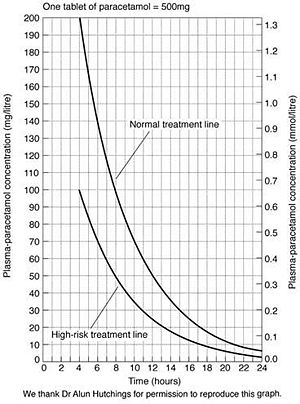Paracetamol overdose
This page is about the medical treatment of paracetamol overdose. Visit suicide if you want to find more about the mental health aspect of paracetamol overdose.
Definition
Taking more than the recommended amount of paracetamol. (2x500mg, 4 times a day with 6 hour gaps between each dose).
Epidemiology
I think the big red thing covers it. It's more common in girls because it's generally a form of parasuicide but blokes do it too.
Pathophysiology
Basically, paracetamol is metabolised by conjugation with two chemicals called sulfate and glucuronide; some is oxidised by the cytochrome P450 enzyme system. When sulfate and glucuronide run out, P450 takes over completely. The P450 system produces a substance called NAPQI which is metabolised by glutathione, found in the liver cells.
In high levels, the glutathione runs out, leaving NAPQI floating around the liver. NAPQI kills liver cells i.e. it's hepatotoxic. This is what does the damage.
(NAPQI stands for N-acetyl-p-benzoquinoneimine just in case it comes up in a pub quiz.)
Risk Factors

Rather than having specific risk factors for self-harm here, it's probably just best to look at the suicide page. These risk factors are medical. They are classified into high-risk or not high-risk. There are certain criteria which put them into the high-risk category:
- Drugs-inducing the P450 system (alcohol, rifampicin, phenobarbital, isoniazid, phenytoin and carbamezapine)
- Malnourished (anorexia, HIV positive)
- Alcoholic liver disease
- Realistically, any sort of liver failure
Clinical Features
There are three things you definitely need to ask with any overdose are:
- What drug(s)?
- How many?
- When? (Ask specifically if they took them all at once or at different times i.e. staggered overdose)
In terms of further clinical features, they're usually asymptomatic. If they do have symptoms, nausea and vomiting are the most common and most symptoms occur 24 hours after ingestion. Other possible features, usually after apparent recovery are tender hepatomegaly, acute liver failure with encephalopathy, hypotension, hypoglycaemia and acute tubular necrosis (I don't actually know what that is).
Investigations
If you do nothing else, do paracetamol levels 4 hours after the point of ingestion. Before this point, paracetamol is still being absorbed, so if you take blood too early, you're reading will be low. This dictates what treatment you give. Other bloods that you need take are:
- U+Es - creatinine to look for renal failure and have a baseline
- LFTs - ALT > 1000μ/l indicates severe liver failure
- Glucose - hypoglycaemia is common in hepatic necrosis. BM should be checked hourly.
- Clotting screen - prothrombin time (PT) is the best indicator of the severity of liver failure
- INR - checked 12-hourly
- FBC - for a baseline in severe illness
- ABG - acidosis can occur early, even in an asymptomatic patient. 10% of patients with acute liver failure.
- Urine output - if this goes down, there's something seriously up with their kidneys.
It usually takes 2-3 days for the effect of a paracetamol overdose to be at its maximum.
Management
Basically, there are three things you can do. Gastric lavage which consists of sticking a tube down there and sucking out whatever paracetamol is in there. Activated charcoal which adsorbs (sticks to) any paracetamol still in the stomach. NAC (N-acetylcysteine) is a drug which works by a number of different mechanisms to protect the liver from paracetamol toxicity.
You need to monitor all patients. This means checking all the things under the investigations section of this page. NAC treatment should be started within 8 hours of ingestion.
(The following times are from time of ingestion)
Less than 1 hour
- <7.5mg - monitor. The chances are they'll be fine.
- >7.5mg - consider gastric lavage. Benefit from the technique is as of yet unclear.
- >150mg/kg OR >12g (Use smaller dose)
- Start NAC immediately
- Treat with activated charcoal 50g (10g/kg in kids) orally or via ng tube.
4-15 hours
- Start NAC if above appropriate treatment line
- >150mg/kg OR >12g
- Start NAC immediately
<15 hours
- Start NAC immediately
Staggered overdose, unknown ingestion time or unknown dose
- Start NAC immediately
Prognosis
Most will be fine. Of 100 paracetamol overdoses:
- 10 will develop liver failure
- 2 will die